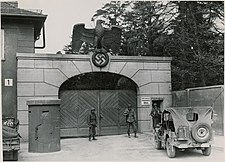Our website is made possible by displaying online advertisements to our visitors.
Please consider supporting us by disabling your ad blocker.
Dachau concentration camp
48°16′08″N 11°28′07″E / 48.26889°N 11.46861°E
| Dachau | |
|---|---|
| Nazi concentration camp | |
 U.S. soldiers guarding the main entrance to Dachau just after liberation, 1945 | |
| Other names | German: Konzentrationslager (KZ) Dachau, IPA: [ˈdaxaʊ] |
| Location | Upper Bavaria, Southern Germany |
| Built by | Germany |
| Operated by | Schutzstaffel (SS) |
| Commandant | List of commandants |
| Original use | Political prison |
| Operational | March 1933 – April 1945 |
| Inmates | Political prisoners, Poles, Romani, Jews, homosexuals, Jehovah's Witnesses, Catholic priests, Communists[1] |
| Number of inmates | Over 188,000 (estimated)[2] |
| Killed | 41,500 (per Dachau website) |
| Liberated by | U.S. Army |
| Website | kz-gedenkstaette-dachau |
Dachau (UK: /ˈdæxaʊ/, /-kaʊ/; US: /ˈdɑːxaʊ/, /-kaʊ/)[3][4] was one of the first[a] concentration camps built by Nazi Germany and the longest-running one, opening on 22 March 1933. The camp was initially intended to intern Hitler's political opponents, which consisted of communists, social democrats, and other dissidents.[6] It is located on the grounds of an abandoned munitions factory northeast of the medieval town of Dachau, about 16 km (10 mi) northwest of Munich in the state of Bavaria, in southern Germany.[7] After its opening by Heinrich Himmler, its purpose was enlarged to include forced labor, and eventually, the imprisonment of Jews, Romani, German and Austrian criminals, and, finally, foreign nationals from countries that Germany occupied or invaded. The Dachau camp system grew to include nearly 100 sub-camps, which were mostly work camps or Arbeitskommandos, and were located throughout southern Germany and Austria.[8] The main camp was liberated by U.S. forces on 29 April 1945.
Prisoners lived in constant fear of brutal treatment and terror detention including standing cells, floggings, the so-called tree or pole hanging, and standing at attention for extremely long periods.[9] There were 32,000 documented deaths at the camp, and thousands that are undocumented.[10] Approximately 10,000 of the 30,000 prisoners were sick at the time of liberation.[11][12]
In the postwar years, the Dachau facility served to hold SS soldiers awaiting trial. After 1948, it held ethnic Germans who had been expelled from eastern Europe and were awaiting resettlement, and also was used for a time as a United States military base during the occupation. It was finally closed in 1960.
There are several religious memorials within the Memorial Site,[13] which is open to the public.[14]
- ^ "Dachau – 7th Army Official Report, May 1945". TankDestroyer.net. May 1945. Archived from the original on 30 January 2016. Retrieved 30 January 2016.
- ^ "Holocaust Encyclopedia – Dachau". United States Holocaust Memorial Museum, Washington, DC. Retrieved 30 January 2016.
- ^ Wells, John C. (2008). Longman Pronunciation Dictionary (3rd ed.). Longman. ISBN 978-1-4058-8118-0.
- ^ "Dachau". Webster's New World College Dictionary.
- ^ Megargee, Geoffrey P., ed. (2009). Encyclopedia of Camps and Ghettos, 1933–1945. Vol. 1, Pt. B: Early camps, youth camps, and concentration camps and subcamps under the SS-Business Administration Main Office (WVHA): Pt. B / vol. ed.: Geoffrey P. Megargee. Vol. 1. Bloomington: Indiana University Press. ISBN 978-0-253-35328-3.
- ^ "Dachau". encyclopedia.ushmm.org. Retrieved 13 April 2022.
- ^ "Ein Konzentrationslager für politische Gefangene in der Nähe von Dachau". Münchner Neueste Nachrichten ("The Munich Latest News") (in German). The Holocaust History Project. 21 March 1933. Archived from the original on 29 November 2017. Retrieved 8 May 2015.
The Munich Chief of Police, Himmler, has issued the following press announcement: On Wednesday the first concentration camp is to be opened in Dachau with an accommodation for 5000 persons. 'All Communists and—where necessary—Reichsbanner and Social Democratic functionaries who endanger state security are to be concentrated here, as in the long run it is not possible to keep individual functionaries in the state prisons without overburdening these prisons, and on the other hand these people cannot be released because attempts have shown that they persist in their efforts to agitate and organise as soon as they are released.'
- ^ Concentration Camp Dachau Entry Registers (Zugangsbuecher) 1933–1945. retrieved 13 November 2014
- ^ "Station 7: Courtyard and Bunker". Dachau Concentration Camp Memorial Site. Archived from the original on 21 September 2013. Retrieved 20 September 2013.
- ^ "Station 11: Crematorium". Dachau Concentration Camp Memorial Site. Archived from the original on 21 September 2013. Retrieved 20 September 2013.
- ^ "Investigation of alleged mistreatment of German guards at the Concentration Camp at Dachau, Germany, by elements of the XV Corps". Archived from the original on 3 November 2014. Retrieved 3 June 2015.
- ^ "Headquarters Seventh Army Office of the Chief of Staff APO TSS, C/O Postmaster New York, NY 2 May 1945 Memorandum to: Inspector General, Seventh Army The Coming General directs that you conduct a formal investigation of alleged mistreatment of German guards at the Concentration Camp at Dachau, Germany, by elements of the XV Corps. A. White, Major General, G.S.C. Chief of Staff Testimony of: Capt. Richard F. Taylor 0-408680, Military Government, Detachment I-13, G-3". Archived from the original on 3 November 2014. Retrieved 3 June 2015.
- ^ "Station 12: Religious Memorials". Dachau Concentration Camp Memorial Site. Archived from the original on 21 September 2013. Retrieved 20 September 2013.
- ^ "1945 – present History of the Memorial Site – Dachau Concentration Camp Memorial Site". www.kz-gedenkstaette-dachau.de. Archived from the original on 21 February 2019. Retrieved 21 February 2019.
Cite error: There are <ref group=lower-alpha> tags or {{efn}} templates on this page, but the references will not show without a {{reflist|group=lower-alpha}} template or {{notelist}} template (see the help page).
Previous Page Next Page



